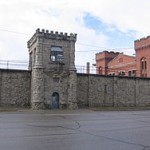I’m not a peevish woman, not really. But I do have a few peeves—not pet peeves, exactly; dogs and cats make much nicer pets. But there are a few common errors in terminology, on the nightly news and in novels, that get my dander up.
And one of those is jail vs. prison. Both are secure structures holding more people than they were built for. They are both stark and noisy, warm enough but physically chilly. They are not nice places, nor are they meant to be.
 Here’s the difference: Jails are, for the most part, facilities housing two kinds of people: those accused of a crime and awaiting trial, or those who have already been convicted of a misdemeanor and are serving their time. They are run by counties or municipalities, although in smaller communities, the towns and cities may have nothing more than a holding tank and contract with the county to house their inmates. When the sheriff of a large Montana county retired and became chief of police in a small town 75 miles away, he could be heard cheering loudly “I don’t have a jail! I don’t have a jail!”
Here’s the difference: Jails are, for the most part, facilities housing two kinds of people: those accused of a crime and awaiting trial, or those who have already been convicted of a misdemeanor and are serving their time. They are run by counties or municipalities, although in smaller communities, the towns and cities may have nothing more than a holding tank and contract with the county to house their inmates. When the sheriff of a large Montana county retired and became chief of police in a small town 75 miles away, he could be heard cheering loudly “I don’t have a jail! I don’t have a jail!”
Prisons, in contrast, are state and federal facilities housing persons convicted of felonies, violent or otherwise. A few states have licensed privately-run prisons. Like the federal system, a state may have several levels of prisons, housing maximum security inmates in one location, medium in another, and low risk in yet another. Many states have separate prisons for women.
Two exceptions I’ve seen: A state facing particularly serious over-crowding may contract with a county that has empty beds for temporary housing for low or medium risk inmates. As well, the federal marshal’s system often contracts with counties to house defendants pending trial, or between conviction and transfer to a federal prison.
Check your jurisdiction for particulars, but know the basic differences.
(Photo of Old Montana Prison from the Montana State Archives.)
